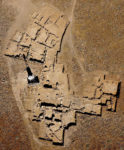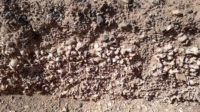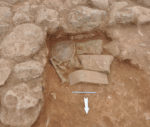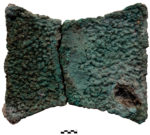 That famous dark red/purple dye so prized by ancient Mediterranean peoples for its depth of color that only increased with time is still known today as Tyrian purple because it was produced and traded extensively by Phoenicia and its colonies. Archaeological evidence points to the Minoans as having beaten the Phoenicians to the punch by centuries. An excavation on the islet of Chryssi in eastern Crete has unearthed remains of an early Minoan-era dye production facility.
That famous dark red/purple dye so prized by ancient Mediterranean peoples for its depth of color that only increased with time is still known today as Tyrian purple because it was produced and traded extensively by Phoenicia and its colonies. Archaeological evidence points to the Minoans as having beaten the Phoenicians to the punch by centuries. An excavation on the islet of Chryssi in eastern Crete has unearthed remains of an early Minoan-era dye production facility.
 The purple dye was manufactured by extracting the secretion from the hypobranchial gland of murex sea snails. The carnivorous molluscs release a bromine compound when attacked, so dye could be extracted by poking and prodding the snails, thus keeping them alive for further production. Much more common, however, was the destruction of the snails and removal of the gland. It was resource-intensive, time-consuming and, according to ancient chroniclers, eye-wateringly smelly work that required processing literally thousands of murex just to produce enough dye for even a single stripe like one on the toga praetexta worn by Roman magistrates.
The purple dye was manufactured by extracting the secretion from the hypobranchial gland of murex sea snails. The carnivorous molluscs release a bromine compound when attacked, so dye could be extracted by poking and prodding the snails, thus keeping them alive for further production. Much more common, however, was the destruction of the snails and removal of the gland. It was resource-intensive, time-consuming and, according to ancient chroniclers, eye-wateringly smelly work that required processing literally thousands of murex just to produce enough dye for even a single stripe like one on the toga praetexta worn by Roman magistrates.
The Chryssi settlement was inhabited from 1800-1500 B.C. and evidence of murex processing, including stone tanks used to farm the sea snails, have been found in structures from the early end of the range. The most recent excavations of a later building from ca. 1500 B.C. revealed murex shells were used in the construction of its walls.
 The large building, B2, is relatively simple in architectural features with focus on practical elements like work surfaces, stoves, slab staircases. Stone tools and pottery types used for cooking and storing food have been recovered from the building. Workmanlike or not, the contents of the dwellings were expensive, high-quality pieces including precious metals, gemstones, copper pots and talents.
The large building, B2, is relatively simple in architectural features with focus on practical elements like work surfaces, stoves, slab staircases. Stone tools and pottery types used for cooking and storing food have been recovered from the building. Workmanlike or not, the contents of the dwellings were expensive, high-quality pieces including precious metals, gemstones, copper pots and talents.
It contained a golden ring, 26 golden beads and a golden bracelet, a silver bead, 5 copper ones and a copper ring sling along with a large number of glass beads of various shapes, four of the so-called Egypt blue, 10 from lapis lazuli, one from amethyst and 20 from carnelian, a seal made of agate with the picture of a ship that its stern had the form of an animal’s head and a stone amulet with the shape of a monkey.
In 2019’s excavations another ‘treasury’ was unearthed that included a big saw and three vases, all made of copper. Their total weight was 68 kilos. It is one of the largest found on Crete so far. Inside a vase, they also found part of a talent made of tin.
 This is only the second tin talent found on Crete.
This is only the second tin talent found on Crete.
The newly-discovered evidence indicates the building was used by people involved in the production and trade of purple dye. Wealthy, but a mercantile rather than a ruling elite.
Those tin ingots –purposely– contained already roughly 10 percent copper, which explains the greenish color. The Uluburun Shipwreck from what is now Turkey, dates to the 14th century BC. Its cargo also included ten tons of raw copper, 354 ingots of the oxhide type, 121 copper bun and oval ingots and approximately one ton of tin, when alloyed 11 tons of bronze.
While later the Greeks traditionally sourced their tin from Cornwall, and the “Tin Islands in the extremity of Europe where we get the tin from” –ἐξ ἐσχάτης δ᾽ ὦν ὁ κασσίτερος ἡμῖν φοιτᾷ καὶ τὸ ἤλεκτρον, this earlier tin ingot here might have come from the east. Thus, i would be interested, if the actual source could be determined and where the copper might have been added.
———
Coming back to the purple, the stuff was by the 6th century BC seemingly not a big hit in nearby Africa (Herodotus Book 3:20-22) :confused:
“Then as soon as the Ichthyophagoi came to Cambyses from Elephantine, he sent them to the Ethiopians, enjoining them what they should say and giving them gifts to bear with them, that is to say a purple garment, and a collar of twisted gold with bracelets, and an alabaster box of perfumed ointment, and a jar of palm-wine. […] Then he took the garment of purple and asked what it was and how it had been made: and when the Ichthyophagoi had told him the truth about the purple-fish and the dyeing of the tissue, he said that the men were deceitful and deceitful also were their garments. Then secondly he asked concerning the twisted gold of the collar and the bracelets; and when the Ichthyophagoi were setting forth to him the manner in which it was fashioned, the king broke into a laugh and said, supposing them to be fetters, that they had stronger fetters than those in their country. Thirdly he asked about the perfumed ointment, and when they had told him of the manner of its making and of the anointing with it, he said the same as he had said before about the garment. Then when he came to the wine, and had learned about the manner of its making, being exceedingly delighted with the taste of the drink he asked besides what food the king ate, and what was the longest time that a Persian man lived.”
They had to milk sea snails…. sounds like a fun time.
UgOVqhSnH